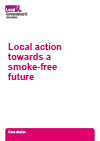
Introduction
In England, local government has had responsibility for stop smoking services and local tobacco control since 2013. Despite deep cuts to the public health grant over this period, almost all local authorities have sustained their support for smokers to quit and many have developed innovative approaches to reduce the harm of tobacco on their local communities.
Local councils have exploited their strengths to bring down local smoking rates. Their reach into communities has helped in tackling the stark inequalities that characterise the population of smokers, such as the stubbornly high smoking prevalence in low income and disadvantaged communities. Their relationships across communities have helped to build partnerships with the capacity to tackle the harms of tobacco on multiple fronts: supporting smokers to quit, communicating with local people to deter new smokers and encourage smokers to quit, reducing the illicit trade, creating smoke-free public spaces, and promoting harm reduction approaches.
Smoking remains the leading preventable cause of ill health and mortality in England. Councillors and officers recognise the harm that smoking inflicts on their communities and the importance of continuing to drive down smoking prevalence. The goal of a smoke-free community no longer seems out of reach but there is still much to be done to achieve it.
These case studies describe the efforts of local councils across England to improve health and wellbeing through tackling smoking. They capture the diversity of local authority approaches and some of the successes that local government can celebrate and build on.
Councillor David Fothergill, Chairman, LGA Community Wellbeing Board
